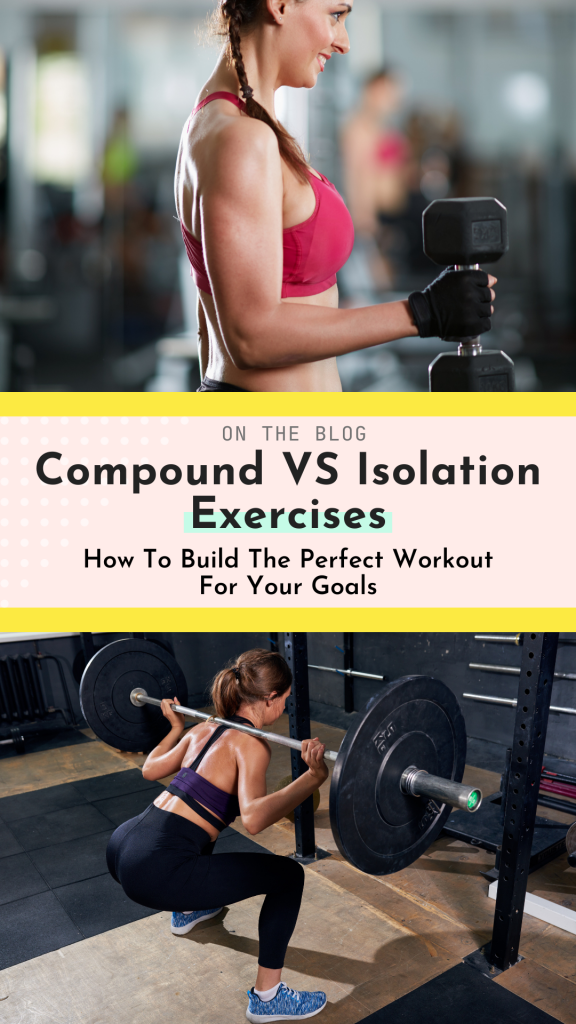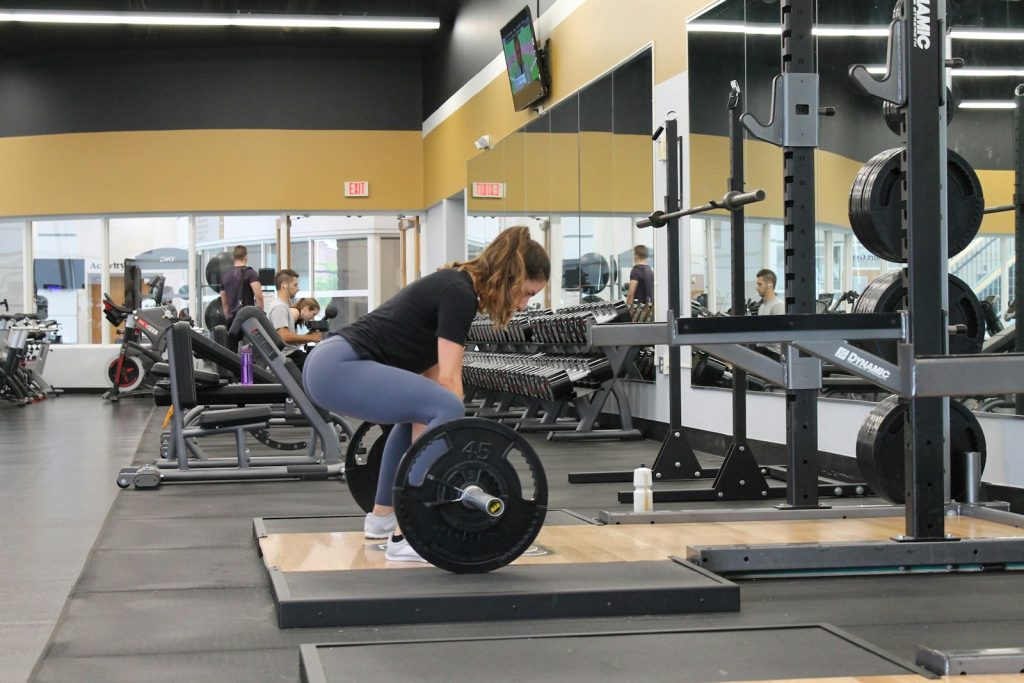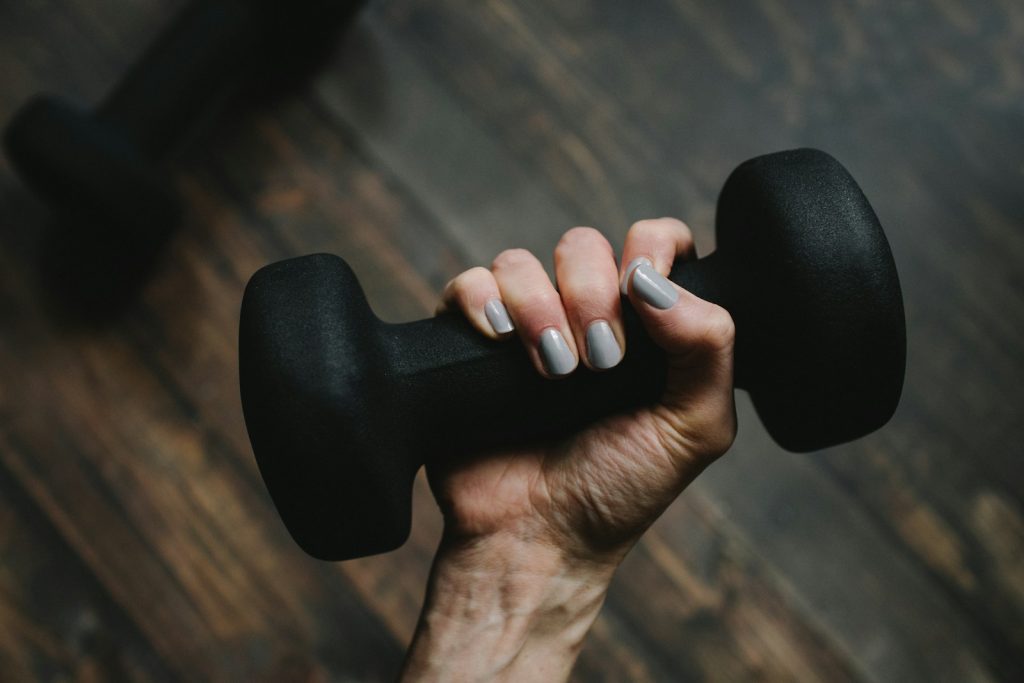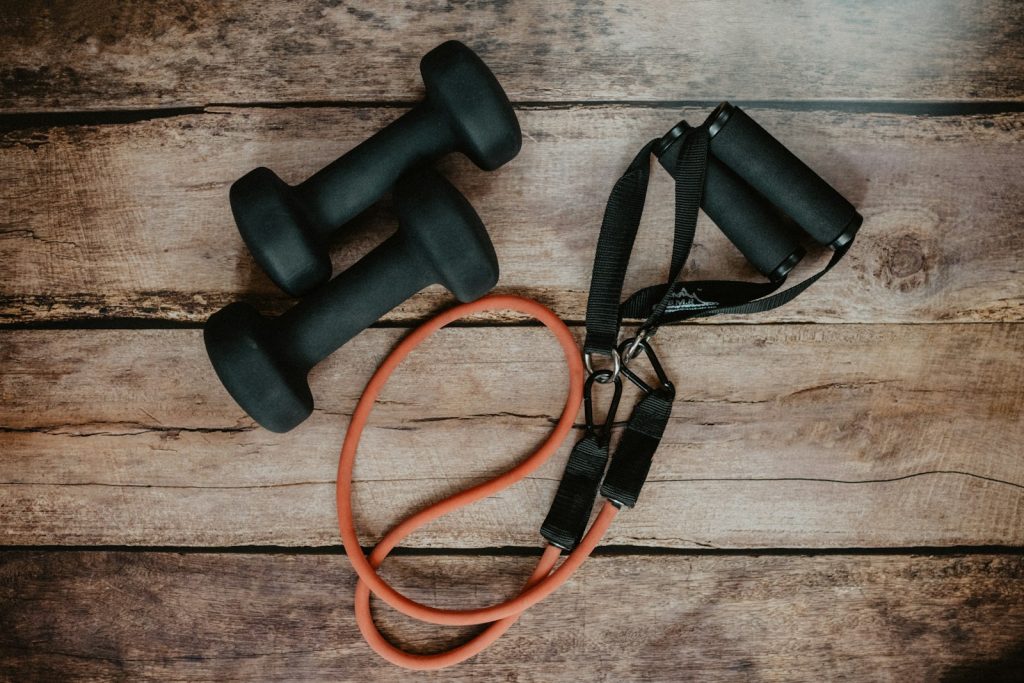This post may contain affiliate links, which means that I may earn a commission if you click on the link or make a purchase using the link. When you make a purchase, the price you pay will be the same whether you use the affiliate link or go directly to the vendor’s website using a non-affiliate link.
Introduction
Have you recently started weight training and want to know the best way to train different muscles? Should you focus on compound exercises or isolation exercises, or do you need help finding a balance between the two? Designing the perfect workout routine for yourself can be tough when you’re new to exercise. In this post I want to talk about compound vs. isolation exercises, what they are and the benefits of both – whether you’re aiming for strength, muscle definition, weight loss, or overall fitness.
LEARN THE BEST WAY TO STAY CONSISTENT WITH EXERCISE > Enjoy Movement: How To Find Fun In Every Workout

Table of Contents
- Introduction
- What Are Compound Exercises
- What Are Isolation Exercises
- Compound VS Isolation Exercises: Key Differences
- Advantages of Compound Exercises
- Advantages of Isolation Exercises
- Compound vs. Isolation Exercises: Incorporating Both in Your Workout Routine
- Tips for Beginners
- Tailoring Workouts to Personal Goals
- Common Myths and Misconceptions of Compound vs. Isolation Exercises
- Compound vs. Isolation Exercises: Conclusion
What Are Compound Exercises
Compound exercises are exercises that work more than one muscle group at a time, and involve movement across two or more joints.
Common Characteristics Of Compound Exercises
- Multi-Joint Movements: Compound exercises involve movement at more than one joint, leading to a more comprehensive activation of your muscles. For example, squats engage your hips, knees, and ankles, working the quads, hamstrings, glutes, and lower back at the same time.
- Functional Mimicry: A lot of compound movements mimic everyday activities and your natural body mechanics. This functional aspect makes compound exercises not only great for building strength but also for improving overall functionality in daily life.
- High Intensity: Because you are using more muscle groups, compound exercises usually need more energy, resulting in a higher intensity workout. This can contribute to burning more calories and improving your cardio endurance.
What Are Isolation Exercises
Isolation exercises are designed to target and strengthen specific muscles independently. In contrast to compound exercises, which involve multiple muscle groups, isolation movements zero in on a single muscle group, offering a more focused and controlled approach to training.

Common Characteristics Of Isolation Exercises
- Single-Muscle Focus: Isolation exercises isolate a specific muscle, emphasizing controlled movements that only engage that specific muscle group. An example would be the leg extension, which mainly targets your quads.
- Precise Movements: Isolation exercises involve simpler, more direct movements that isolate the muscle being worked. The emphasis is on precision and deliberate muscle engagement.
- Controlled Range of Motion: Isolation exercises allow for a more controlled range of motion, allowing you to concentrate on the targeted muscle without the interference of other muscle groups.
The type of exercises you choose plays a big role in fat loss. Learn more about balancing your routine in Burn Fat Not Muscle.
Compound VS Isolation Exercises: Key Differences
The key differences between compound and isolation exercises starts with understanding the scope of muscle engagement in each category.
- Compound Exercises:
- Engage Multiple Muscle Groups: Compound exercises involve various muscle groups working together during a single movement.
- Comprehensive Activation: Movements like squats, deadlifts, and bench presses activate large muscle masses across multiple joints.
- Holistic Development: These exercises contribute to overall strength and muscle development, promoting balance and symmetry in the body.
- Isolation Exercises:
- Target Specific Muscle Groups: Isolation exercises focus on working a single muscle group at a time.
- Precision Muscle Engagement: Movements like bicep curls, leg extensions, and lateral raises isolate and intensively work specific muscles.
- Customizable Focus: Ideal for addressing specific weaknesses or imbalances and refining the definition of particular muscle groups.

Looking to target your lower body? Check out my Leg and Glute Workout Plan for exercises you can do at home or at the gym.
Advantages of Compound Exercises
Increased Calorie Burn
One of the standout advantages of incorporating compound exercises into your workout routine is the boost they provide to calorie burn and metabolic activity.
- High Energy Expenditure: Compound exercises demand a higher energy expenditure during your workout. This increased intensity translates into burning more calories, making these movements effective if you’re aiming to lose weight or maintain a healthy body composition.
- Elevates Metabolic Rate: Engaging in compound movements triggers a substantial metabolic response. Your body works harder to support the coordination of different muscle groups, leading to an elevation in your metabolic rate. This post-exercise boost can even continue burning more calories after you’ve finished your workout.
Functional Fitness
The benefits of compound exercises go beyond the gym, helping to improve functional fitness that directly impacts your day-to-day life.

- Mimics Real-Life Movements: Compound exercises often mimic natural, real-life movements. Squats copy the motion of sitting and standing, deadlifts imitate picking up objects from the ground, and bench presses mimic pushing actions. Functional fitness is crucial to overall wellbeing and longevity.
- Enhances Joint Stability: Since compound exercises engage multiple joints, they contribute to improved joint stability. The coordinated effort need to perform the movements promotes better joint function, reducing the risk of injuries and improving overall joint health.
Time-Saving
If you don’t have a lot of time to workout, compound exercises come to the rescue as efficient time-savers. Think about squats – they work your legs, butt, and even your core all together. Because you’re hitting so many muscles in one go, you need fewer exercises to get a full-body workout. This not only saves you time but also makes your workout more effective.
Advantages of Isolation Exercises
Targeted Muscle Development and Definition

- Focused Muscle Engagement: Isolation exercises give special attention to individual muscles. Movements like bicep curls, tricep extensions, or leg curls isolate and intensely work one muscle at a time, enhancing its strength and promoting targeted growth.
- Refine Aesthetic Appearance: Isolation exercises are particularly valuable for refining the appearance of your muscles. If you’re aiming for well-defined biceps, triceps, or other specific muscle groups, isolations are the go-to choice.
Address Muscle Imbalances and Specific Weaknesses
- Balancing the Equation: If you’ve noticed that certain muscles are weaker than others in strength or development, isolations can help to even things out.
- Rehabilitation and Injury Prevention: Isolation exercises are gentler on joints and are often recommended if you’re recovering from an injury. They are a more controlled way of strengthening specific muscles, aiding in rehabilitation and reducing the risk of further injury.
Compound vs. Isolation Exercises: Incorporating Both in Your Workout Routine

The ideal ratio of isolation to compound exercises in a muscle-building routine varies depending on your own individual goals, preferences, and the specific muscles you want to target. But, a general guideline for a standard muscle building routine is to prioritise compound exercises, as they provide a strong foundation for overall muscle development and strength. Here’s a basic guideline to workout each muscle group (upper and lower body):
- Compound Exercises:
- Focus on compound exercises that target major muscle groups, like squats, deadlifts, bench presses, overhead presses, pull-ups, and rows.
- Include 2-4 compound exercises per workout session.
- Isolation Exercises:
- Supplement your routine with isolation exercises to target specific muscle weaknesses or imbalances and to enhance muscle definition.
- Include 1-2 isolation exercises per major muscle group targeted in your workout.
- Frequency:
- Aim for 2-3 workouts per week for each muscle group, and allow for rest and recovery. If you are short on time, include full-body workouts rather than split days.
Tips for Beginners
For complete fitness beginners, it’s important to choose appropriate exercise types to establish a solid foundation and prevent injury.
- Compound Exercises for Beginners:
- Compound exercises are more suitable for beginners as they engage multiple muscle groups, providing a better workout in a shorter time.
- Focus on fundamental compound movements like bodyweight squats, push-ups, and assisted pull-ups to build a strong base of overall strength.
- Isolation Exercises for Beginners:
- While isolation exercises have their benefits, as a beginner it’s better to prioritise compound movements initially to improve core strength and coordination.
- As you progress, you can gradually introduce isolation exercises to address specific muscle weaknesses or aesthetic goals.
Once you know your workout types, it’s easier to make exercise a habit. I’ve shared more tips in 10 Simple Tricks for Exercise Habits.
Gradually Incorporating Compound and Isolation Movements
- Start with Fundamentals:
- Begin with basic compound movements that use body weight or light resistance, like bodyweight squats, push-ups, and assisted pull-ups.
- Focus on proper form and technique before progressing to more complex exercises or heavy weights.
- Gradual Progression:
- Gradually increase resistance (dumbbells, barbells) as your strength and form improve.
- Start with lighter weights and gradually increase the load to allow your muscles and joints to adapt.
- Include Core Stabilization:
- Start including exercises that enhance core stability, as a strong core is foundational for both compound and isolation movements.
- Address Weaknesses Mindfully:
- As you become more comfortable with your routine, learn your specific muscle weaknesses or imbalances.
- Introduce isolation exercises strategically to target those areas, but maintain a balance with compound movements to continue to build strength.
- Listen to Your Body:
- Pay attention to how your body responds to different exercises. If you are in pain or feel uncomfortable, look at your form or ask for help.
- Don’t try too much at once, allow your muscles and joints to adapt gradually.
- Seek Professional Help:
- Think about working with a personal trailer, especially in the early stages of your fitness journey. They can provide personalised help, ensuring safe and effective progression.

Tailoring Workouts to Personal Goals
- Strength Goals:
- If your goal is to build overall strength and power, compound exercises should be your priority. Movements like squats, deadlifts, and bench presses engage large muscle groups, giving you a solid foundation for strength development.
- Prioritize lower rep ranges (4-8 reps) with heavier weights.
- Supplement with isolation exercises for muscle balance.
- Muscle Hypertrophy (Size) Goals:
- If you’re aiming to increase muscle size (hypertrophy), a combination of compound and isolation exercises is effective. Compound movements initiate muscle growth, while isolation exercises target the development of specific muscle groups.
- Use moderate rep ranges (8-12 reps) with lower weights to induce muscle hypertrophy.
- Aesthetic and Definition Goals:
- If aesthetics is your goal, you will benefit from a mix of compound exercises for overall muscle development and isolation exercises to enhance specific muscle definition. Tailor your routine based on the areas you want to enhance.
- Focus on moderate rep ranges (8-12 reps) for compound movements and higher reps (12-15+) for isolation exercises.
- Include cardio exercises for fat reduction and calorie burn.
- Rehabilitation and Injury Prevention:
- If your focus is on rehabilitation or injury prevention, incorporate more isolation exercises. These will allow for targeted strengthening of specific muscles without placing excessive stress on weakened joints.
- Prioritise controlled movements with lighter resistance to avoid injuries.

POSTS YOU MAY BE INTERESTED IN:
- Mastering Habit Formation And Behaviour Change For Your Health
- Smart Weight Loss Goals: How To Make A Plan To Lose Weight
Common Myths and Misconceptions of Compound vs. Isolation Exercises
- Myth: Only Compound Exercises Build Real Strength:
- Reality: While compound exercises are foundational for overall strength development, isolation exercises play their role in targeting specific muscles and addressing weaknesses. Both contribute to a well-rounded strength training routine.
- Myth: Isolation Exercises Are Only for Bodybuilders:
- Reality: Isolation exercises benefit everyone, not just bodybuilders or fitness fanatics. They help with muscle imbalances, aesthetic goals, and rehabilitation.
- Myth: Compound Exercises Alone Are Sufficient for Aesthetics:
- Reality: While compound exercises are great for overall muscle engagement, isolation exercises are key for working specific muscles and achieving aesthetic goals.
Compound vs. Isolation Exercises: Conclusion
To wrap up the compound vs. isolation debate, the key is to understand that both types of exercises bring unique benefits to your fitness journey. Compound exercises, like squats and deadlifts, build overall strength efficiently, engaging multiple muscles at once. Whereas, isolation exercises, like bicep curls and leg extensions, target muscle development and definition. The best approach is not to choose one over the other but to find the right balance for you. Whether you’re aiming for strength, aesthetics, or overall health and fitness, including a good mix of compound and isolation exercises ensures a well-rounded and effective workout routine. So, find what works for your goals, progress at your own pace, and enjoy your new found strength along the way.
Do you lean more towards compound exercises, isolation movements, or enjoy both? Let me know in the comments below!